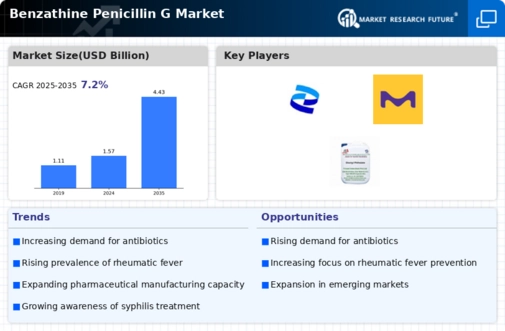Market Growth Projections
The Global Benzathine Penicillin G Market Industry is projected to experience substantial growth over the next decade. With an anticipated market size of 1.57 USD Billion in 2024, it is expected to reach 4.43 USD Billion by 2035. This growth reflects a compound annual growth rate of 9.89% from 2025 to 2035. Such projections underscore the increasing recognition of Benzathine Penicillin G's role in public health and its potential to address various infectious diseases. The market dynamics are influenced by factors such as rising healthcare expenditures and the ongoing need for effective antibiotic therapies.
Emergence of New Treatment Protocols
The emergence of new treatment protocols that incorporate Benzathine Penicillin G is shaping the Global Benzathine Penicillin G Market Industry. Healthcare professionals are increasingly adopting evidence-based practices that highlight the efficacy of this antibiotic in various clinical scenarios. For instance, its role in treating syphilis and preventing rheumatic fever has been underscored in recent guidelines. As these protocols gain traction, the demand for Benzathine Penicillin G is expected to rise, further solidifying its position in the market. This trend indicates a broader acceptance of Benzathine Penicillin G as a vital therapeutic agent.
Regulatory Support for Antibiotic Use
Regulatory bodies worldwide are increasingly recognizing the importance of Benzathine Penicillin G in treating bacterial infections. This support is reflected in streamlined approval processes and guidelines that promote its use in clinical settings. The Global Benzathine Penicillin G Market Industry benefits from such regulatory frameworks, which encourage healthcare providers to utilize this antibiotic effectively. As guidelines evolve to address antibiotic resistance and promote appropriate usage, the market is likely to experience sustained growth, ensuring that Benzathine Penicillin G remains a cornerstone in infectious disease management.
Growing Awareness of Preventive Healthcare
There is a notable shift towards preventive healthcare, which is influencing the Global Benzathine Penicillin G Market Industry. Healthcare providers are increasingly advocating for the use of Benzathine Penicillin G as a prophylactic measure against rheumatic fever and other infections. This trend is particularly evident in developed nations, where public health campaigns emphasize the importance of early intervention. As a result, the market is projected to grow from 1.57 USD Billion in 2024 to 4.43 USD Billion by 2035, reflecting a compound annual growth rate of 9.89% from 2025 to 2035.
Rising Incidence of Rheumatic Heart Disease
The increasing prevalence of rheumatic heart disease globally drives the demand for Benzathine Penicillin G. This condition, often resulting from untreated streptococcal throat infections, necessitates long-term antibiotic prophylaxis to prevent complications. The Global Benzathine Penicillin G Market Industry is expected to see a surge in usage as healthcare systems prioritize preventive measures. In regions where rheumatic heart disease is endemic, such as parts of Africa and South Asia, the need for effective treatment options remains critical. As awareness and screening programs improve, the market is likely to expand significantly.
Expansion of Healthcare Infrastructure in Developing Regions
The expansion of healthcare infrastructure in developing regions is a significant driver for the Global Benzathine Penicillin G Market Industry. As countries invest in healthcare facilities and services, access to essential medicines, including Benzathine Penicillin G, improves. This is particularly relevant in low- and middle-income countries, where the burden of infectious diseases remains high. Enhanced distribution networks and increased availability of healthcare professionals contribute to the rising demand for this antibiotic. Consequently, the market is poised for growth as these regions enhance their healthcare capabilities.













